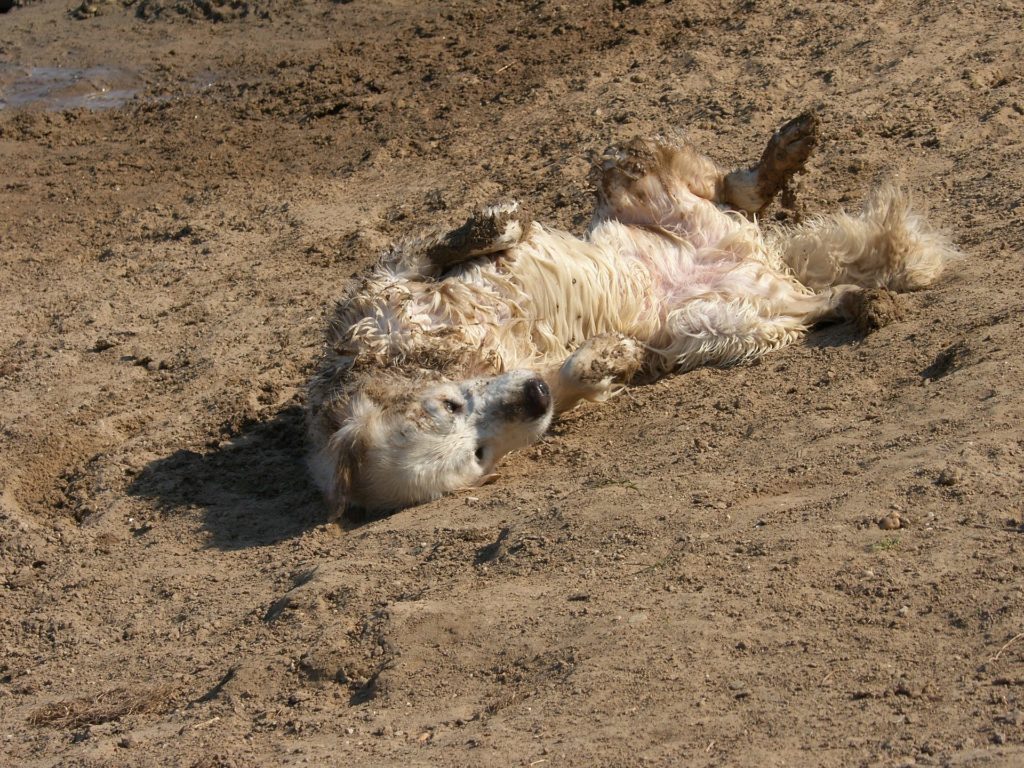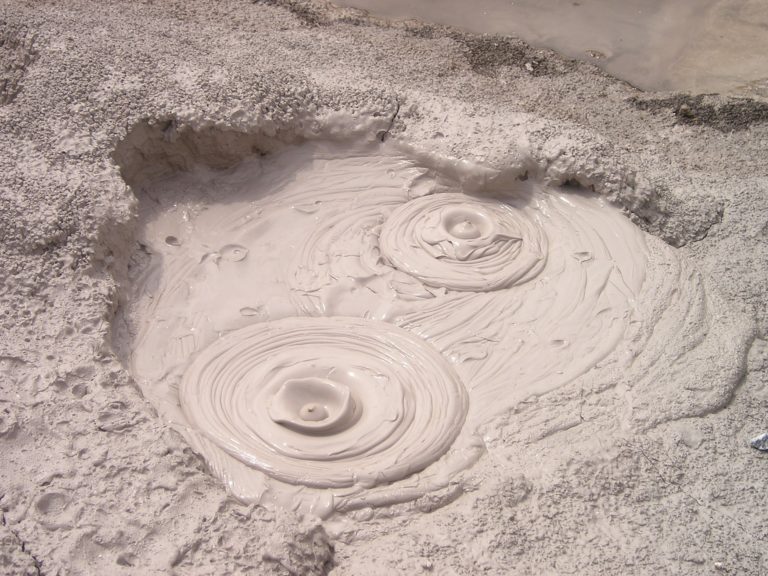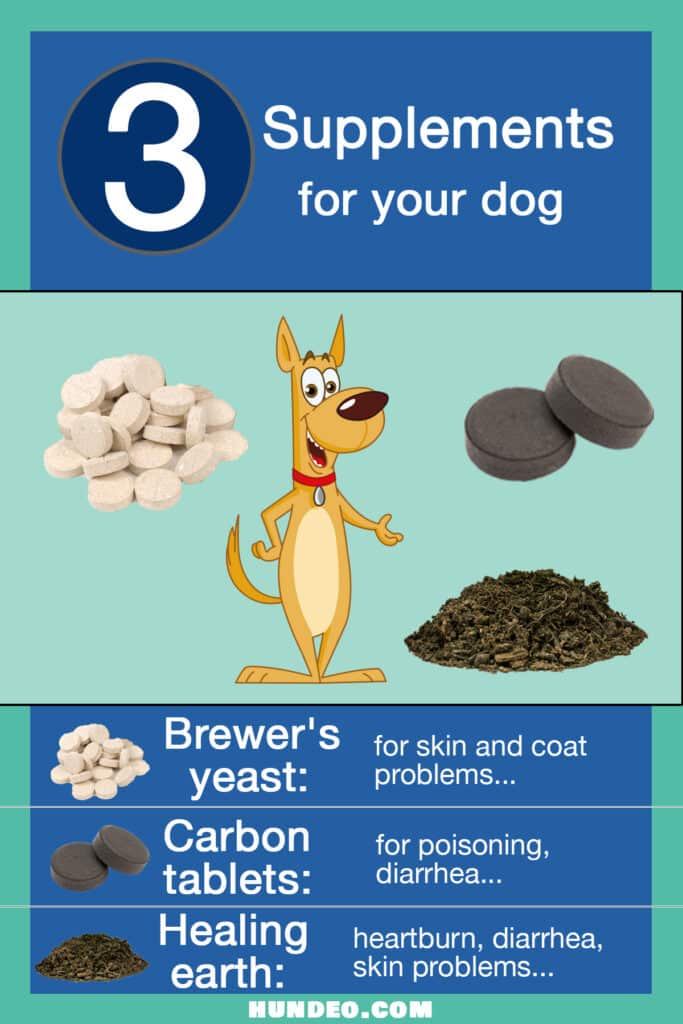5 facts: How to dose and use healing clay correctly
- Veterinarian Mag.med.vet. Emin Jasarevic
- Updated: 2024-02-06
You want to know what you can use healing clay for your dog and why it is so helpful? Here we tell you everything you need to know. In addition, for this article we have obtained advice from the veterinarian Mag.med.vet. Emin Jasarevic.

History to the healing earth
Lutheran pastor and naturopath Emanuel Felke (1856-1926) observed an injured dog one day....
He rolled around in the mud with open wounds. Felke did not give him much chance of survival. The injuries were too severe and the risk of infection too high.
He was all the more surprised when he saw the dog again after only a few days - the wounds had healed and the animal was well.
Could it be that the mud on the road led to this amazing healing? Emanuel Felke devoted himself to this question and, as a so-called "clay priest," founded health spas where healing clay was administered to treat a wide range of ailments.
"What helps with dogs also helps with humans," the priest may have thought.
And really: healing clay became an integral part of natural healing methods. From there, the earthy miracle cure is now coming back "on the dog".
Pet owners found that healing clay works just as well for their animals as it does for humans. For humans and animals can benefit equally in many cases, which is why healing clay should not be missing in any pet pharmacy.
What is healing clay?

Healing earth consists mostly of loess, loam, clay or bog soil. They are cleaned, dried, pulverized and then sterilized by heat. Healing earth contains valuable minerals and trace elements, depending on the mining area (mostly Morocco) in different composition.
What's inside?
Healing clay contains a lot of vital minerals and trace elements, depending on the mining area in different contents. These are mainly:
- Silicate
- Calcite
- Three-layer clay minerals
- Feldspar
- Dolomite
Silicon, calcium, iron, potassium, magnesium and sodium, as well as copper, manganese, nickel, selenium and zinc.
These substances can have a positive effect on the skin tissue and internal organs. If your pet is healthy, it does not need food supplements. But the healing clay can be supportive for sick animals.
Active ingredients
Silicic acid (also known as silicon/silicate), for example, ensures a firm and elastic skin surface and influences its metabolism. It is also important for healthy bones, as is the calcium it contains. This in turn contributes to cell regeneration, which positively supports healing processes.
Potassium is also vital so that nerve and muscle cells can communicate with each other. Iron is important for the formation of blood pigment, magnesium supports the metabolism of the muscles. Selenium acts as a protective shield, zinc helps with the production of new tissue and copper inhibits inflammation.
All this and much more is contained in healing clay. That is why it is also a product that can be used in so many ways.
Whether gastrointestinal complaints or skin problems, inflamed joints or an injury, healing clay can support healing in humans and pets alike.
What should I look for when buying?
It is not absolutely necessary to resort to products that are provided with these additional active ingredients. Healing clay in its original form is quite an inexpensive product.
Stored in a dry place, it has a long shelf life. Healing clay is freely available and is considered a dietary supplement or cosmetic product.
It is important to pay attention to origin and quality, so that an optimal effect is achieved and no harmful substances enter the organism.
Moreover, it is not intended for permanent use, but as an application for acute complaints or as a cure (not longer than 6 weeks).
Which healing clay to buy?
Healing clay products are available in pharmacies, health food stores, drugstores and online stores. There are the following forms:
- Powder
- Granules
- Tablets
- Capsules
- Ointment
You are welcome to buy a powder for your protégé that is intended for humans. I recommend the well-known bestseller from Luvos.
How does healing clay work?
Healing clay can be used both internally and externally. It has an absorbent, antibacterial and alkaline effect.
Inner application
Due to its special structure, healing clay works like a small sponge that absorbs harmful substances and removes them from the body.
In the case of diarrhea, for example, it can absorb toxins and bind excess water. The substances are then removed via the digestive tract.
External application
When applied externally, an inflammatory process can be absorbed from the inside out.
The earth, applied cold, has an analgesic, anti-itching and anti-inflammatory effect. Wound secretions can also be bound with healing clay. Warm or hot compresses have an antispasmodic effect and promote circulation.
The metabolism in the respective affected area is boosted and stimulates the oxygen supply.
8 Applications of healing clay
1. osteoarthritis, joint and muscle diseases
Owners of older dogs are usually familiar with the inflammatory changes in the joints of their four-legged friends. Climbing stairs, jumping into the car, fetching sticks or simply standing up, all this is associated with pain.
Osteoarthritis cannot be cured and progresses as your pet ages. But we dog owners can influence the course of the disease! The use of healing clay can be a way of keeping your furry friend as mobile as possible.
Cold compresses with healing clay have proven particularly effective. This can simply be mixed with water to form a paste and applied. After 15 minutes, everything should be washed off again. The earth has then absorbed so much body heat that it is no longer cooling. There is even an opposite effect, as it radiates heat back.
If you don't want to ruin your home furnishings with a mud-encrusted dog, use cotton cloths for the compresses. These are permeable and transfer the active ingredients to the skin. The treatment must be carried out continuously over a longer period of time in order to achieve an effect.
Can be treated in the same way:
- Bruises
- Crushes
- Tendonitis
- Rheumatic complaints
2. heartburn
Our dogs can also suffer from an excess and foaming of stomach acid. Triggers can be stress, food intolerances, unsuitable food (too fatty, too cold, too hot, spoiled) or stomach diseases.
Symptomatically, your charge will exhibit frequent smacking, empty swallowing, excessive licking, or addictive eating of grass.
Some dogs suffer from hyperacidity when their stomach is too empty. Here, healing clay can also provide relief. Due to its alkaline properties, the stomach acid is bound and the base-acid balance is balanced.
The healing clay is best administered as a powder together with the food. Simply sprinkle it on bar food and wet food, mix it with water and add it to dry food.
If the symptoms do not return or return, then contact your veterinarian. Here it is important to find the cause.
3. diarrhea
Healing clay is also useful for diarrhea. With this illness, the body's mineral balance is quickly upset. Healing clay can balance this out. It also absorbs toxins in the intestines and promotes elimination. At the same time, it also binds excess water ("constipating effect") so that your pet's stool should soon be back to normal.
When does diarrhea become dangerous?
If the diarrhea lasts longer, is particularly severe or even bloody, a vet should be consulted. If vomiting and refusal of water are added to this, your faithful companion can quickly be in danger. Fluids may need to be administered via an infusion. Possible causes may include infections, worm infestations or allergies.
4. irritated bowel
Internal use has also proven effective for irritable bowel syndrome. As a cure over several weeks, the intestinal flora of your four-legged friend can be rehabilitated. The intestines can also become unbalanced after antibiotics. Here, a cure application is recommended for regeneration.
5. giardia infestation
If giardia are the cause of diarrhea, healing clay also helps. The pathogens often occur in young dogs and dogs with weakened immune systems. Giardia love carbohydrates. These should be eliminated from the diet. Remember that fruit and some vegetables also contain carbohydrates.
6. feces eating
Which dog owner does not know this? Especially young dogs like to eat their own or their peers' feces. But not only those - also human excrements, horse droppings, sheep dung or cow dung. Apart from the fact that it is decidedly unappetizing, it can also have health consequences for our four-legged friends.
Why does my dog do that?
In any case, eating feces is a sign of a deficiency. The faeces contain special enzymes that are only broken down during the digestive process. And these ingredients are interesting for our dogs.
Experience shows that healing clay can also help here. This provides the dog's household with sufficient minerals and trace elements.
7. skin problems
One in five dogs in Germany suffers from allergies. The most common of these is "atopic dermatitis" - a hypersensitivity to foreign substances. This is followed in second place by flea allergies and in third place by food intolerances.
Regardless of the cause, skin rashes can be treated with healing earth. The earth itself is considered non-allergenic. It cools, relieves itching, dries and absorbs wound secretions. Inflammations can heal more quickly.
8. bouncing lodgers
Healing clay can also be helpful in the fight against fleas. Due to its absorbency, it also has a drying effect on fleas by settling in their chitinous carapace.
You can use it to sprinkle hard-to-reach places like cracks in your home. The powder must be used regularly and vacuumed well before each new application.
Caution! Due to its drying effect, it is not recommended to apply the healing clay as a loose powder to your dog's skin or coat. On dry skin, the powder can cause skin problems such as itching.
Healing clay dosage
As a general rule, first test a smaller amount than the specified dose on the animal. If this is well tolerated, one can increase the dose to the appropriate level.
Powder, tablets or capsules?
There are different grinds of healing clay powder, depending on whether it is intended for internal or external use. Therefore, you should follow the manufacturer's instructions.
Otherwise, the following rule of thumb applies to the intake of powder, capsules or tablets:
- Small dogs: 0.5-1 teaspoon / 1-2 capsules / tablets
- Medium dogs: 1 teaspoon / 2 capsules / tablets
- Large dogs: 1-1.5 teaspoons / 3 capsules / tablets
- Very large dogs: 1 tablespoon / 3-4 capsules/tablets
This is the best way
Healing earth can simply be sprinkled on wet food and bar food. For dry food, it has proven useful to mix the earth with water and let it be absorbed by the dry food. Healing clay has no particular taste of its own, so it can also be hidden well in liverwurst or cheese morsels.
compresses, compresses, compresses
For external use, a ready-to-use paste is recommended for smaller needs. Otherwise, healing clay is simply mixed with water (cold or warm water, depending on the indication) and applied as a compress or placed as a poultice. After 15 minutes, you should stop the treatment or replace the healing clay.
Side effects
Scientifically, the effectiveness of healing clay has not yet been proven. But the empirical knowledge of users testifies to its healing power. And everything that works can, of course, have side effects.
Caution with medications
Thus, when taking healing clay, the active ingredients of medications that are also taken can be affected. As is well known, healing clay works like a sponge and binds substances to itself, including those from the medications. Therefore, a gap of two hours between taking healing clay and medication is recommended.
Keeping an eye on the kidneys
It is also discussed whether the increased silicon intake supports the formation of urinary stones. Healing clay is also suspected of attacking the kidneys. However, studies are lacking on this.
Carrier intestine
Due to its water-binding properties, internal use may cause constipation. It is important to make sure to always add enough liquid.
No direct skin contact with dry powder
Also, healing clay in powder form should not be applied directly to the skin, as it dries it out too much. This can result in itching and inflammation.
Healing clay is considered non-allergenic and can be used well by lay people. It is easy to administer, but should not act as a permanent gift. The application is symptom-related or as a cure. If symptoms remain or worsen, the use of healing clay does not replace a visit to the vet!

Frequently Asked Questions
Healing earth consists mostly of loess, loam, clay or bog soil. They are cleaned, dried, pulverized and then sterilized by heat. Healing clay contains valuable minerals and trace elements.
Healing clay contains minerals and trace elements:
- Silicate
- Calcite
- Three-layer clay minerals
- Feldspar
- Dolomite
In these minerals are connected, among others, the following chemical elements and trace elements:
Silicon, calcium, iron, potassium, magnesium and sodium, as well as copper, manganese, nickel, selenium and zinc.
Healing clay products are available in pharmacies, health food stores, drugstores and Internet stores. They come in various forms. For your protégé, you can also buy a powder that is intended for humans.
You can use healing clay on your dog both internally and externally. Internally, it helps with heartburn, gastrointestinal problems and diarrhea. Externally, it can promote wound healing, relieve arthritis and kill fleas.
There are different grinds depending on whether it is for internal or external use. Therefore, you should follow the manufacturer's instructions.
Otherwise, this rule of thumb applies:
- Small dogs: 0.5-1 teaspoon / 1-2 capsules / tablets
- Medium dogs: 1 teaspoon / 2 capsules / tablets
- Large dogs: 1-1.5 teaspoons / 3 capsules / tablets
- Very large dogs: 1 tablespoon / 3-4 capsules/tablets
Veterinarian’s Recommendation
As you can see, healing clay works for many diseases. Either it alleviates the symptoms or even has a healing effect.
I personally have a pack of the capsules at home in my pet pharmacy and use them when my dog occasionally has mild heartburn.
Please note that healing clay does not replace a visit to the vet.

I am a veterinarian and writer on animal health topics. Animals are my passion, and it is my personal goal to create medically accurate articles and videos to educate pet owners as much as possible.
Share Now:

